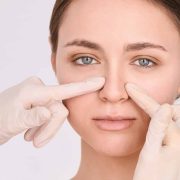Will the Nose Tip Fall After Rhinoplasty?
After Rhinoplasty surgeryIt is normal for the nose to be a little swollen and bruised. This swelling and bruising usually subsides within the first few weeks after surgery. However, permanent problems such as drooping or collapsing of the nose may rarely occur.
Falling or collapsing of the nose may be caused by complications such as incorrect surgical techniques or inadequate support of the tissue after rhinoplasty. Such problems may be more common in rhinoplasty procedures performed by surgeons who do not have surgical experience or appropriate training.
Rhinoplasty surgeryIt is a procedure designed to correct the shape of the nose and make aesthetic improvements. When this procedure is performed under the management of an experienced and expert plastic surgeon, problems such as permanent falling or collapse are eliminated. rare. However, surgical results may vary from person to person, and any surgery has risks.
If any permanent problems occur after rhinoplasty surgery or if the post-operative results are not as expected, you should contact your surgeon. When evaluated and managed appropriately, complications after rhinoplasty can be minimized and patients often achieve the rhinoplasty they desire.
What is Nose Aesthetics (Rhinoplasty)?
Rhinoplasty, medically known as “rhinoplasty,” is a surgical procedure performed to correct or improve the shape, size or functionality of the nose. This plastic surgery procedure is a preferred option for many people to improve the appearance of their nose or solve breathing problems. During rhinoplasty, the surgeon may reshape the cartilage and bone structure of the nose or correct its size. As a result of the procedure, patients have a more balanced and aesthetic nose.
How to Understand Drooping Nasal Tip?
Drooping or sagging nose tip may be caused by certain features or anatomical changes in the person's nose structure. In order to understand the drooping nose tip, it is important to pay attention to some indicators below:
- Change in Appearance: The droopy tip of the nose can cause the nose to appear drooping or tilted downwards, especially when viewed from the side profile. You may feel that the tip of your nose is lower or tilted than normal.
- Difficulty Breathing: The drooping tip of the nose can sometimes cause narrowing or blockage of the airways inside the nose. This may cause difficulty breathing or nasal congestion.
- Intranasal Problems: Problems caused by drooping nasal tip may lead to changes in the intranasal anatomy. This can cause problems such as nasal congestion, nasal congestion, or frequent infections.
- Nose Aesthetic Changes: Aesthetically, the droopiness of the tip of the nose can affect the overall appearance of the nose. If the tip of the nose is lower than normal, this can affect the balance of the person's face and cause the person to be dissatisfied with the rhinoplasty.
- Understanding by Touch: You can lightly touch the tip of the nose with your hand to better understand the drooping nose tip. If you feel a curvature or sagging in the cartilage at the tip of your nose, it may be a symptom of this condition.
- Professional EvaluationIt is important to have an evaluation by an otolaryngologist or plastic surgeon to determine the exact cause and severity of drooping nasal tip. These specialists can examine the internal structure of the nose using special tests such as x-ray imaging or endoscopic examinations.
Drooping nasal tip is usually corrected by surgical interventions such as rhinoplasty or septoplasty. However, each individual's situation is different and treatment options should be tailored to individual needs and anatomical features. Therefore, it is important to consult an expert when faced with such problems.











